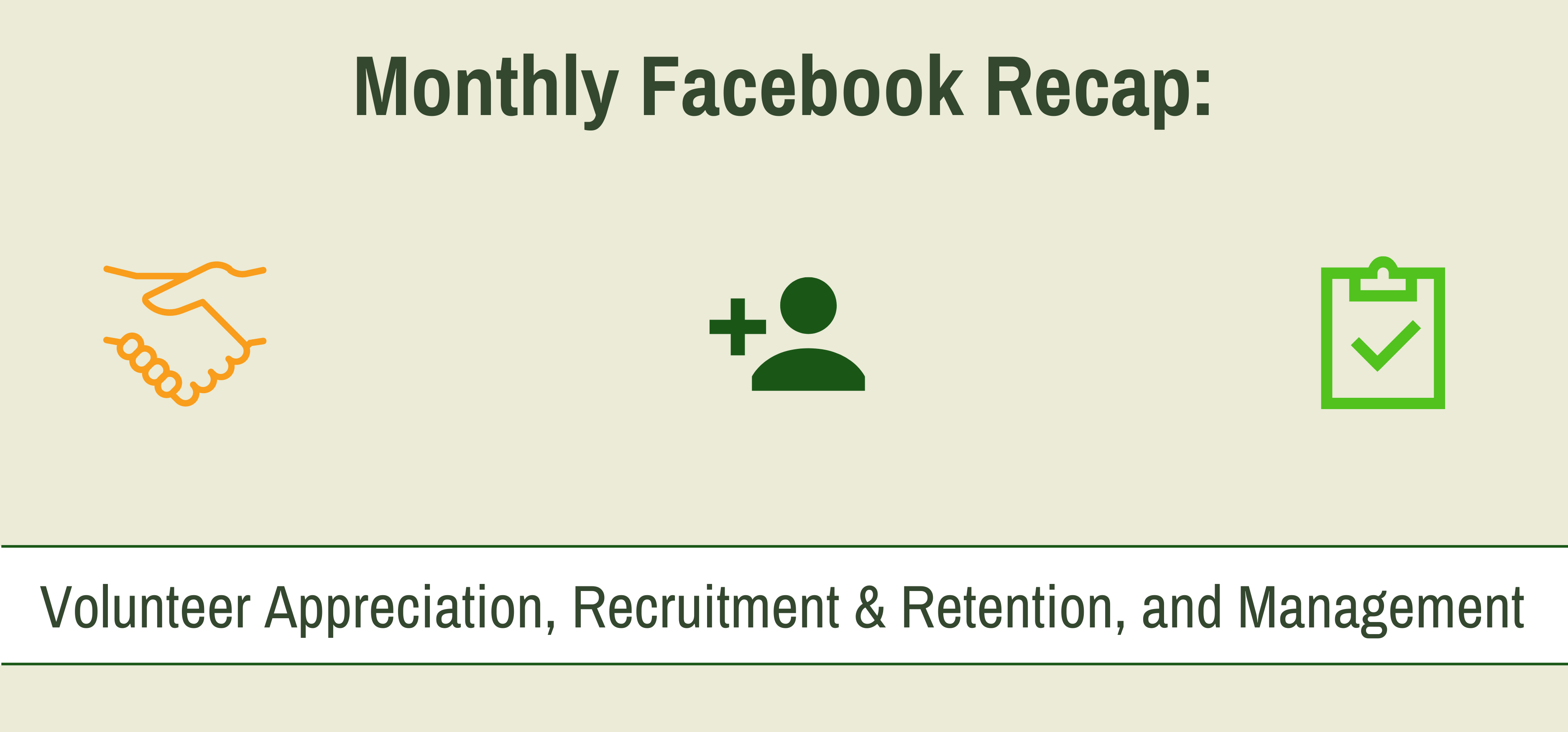
Recap for November 2022
Thank you to everyone who contributed to the Facebook community this past month!
Volunteer Appreciation
Ideas for Volunteer Awards
Volunteer appreciation is important for any volunteer coordinator to consider. Of course, volunteers will get satisfaction from knowing their work makes a difference, but appreciation from peers and supervisors provides an extra incentive. If your organization offers volunteer awards at different intervals, it’s a good idea to find a way to keep track of the hours. Track it Forward volunteer software offers a Milestones feature designed to help administrators and volunteers keep track of their progress toward hours goals. Some great ideas for volunteer awards and appreciation include handwritten cards, plaques, miniature trophies, or branded merchandise. As the holidays approach, there’s also an opportunity to give all volunteers gifts as a token of appreciation. From handmade gifts to paint-along experiences, our coordinator community has some great ideas below:
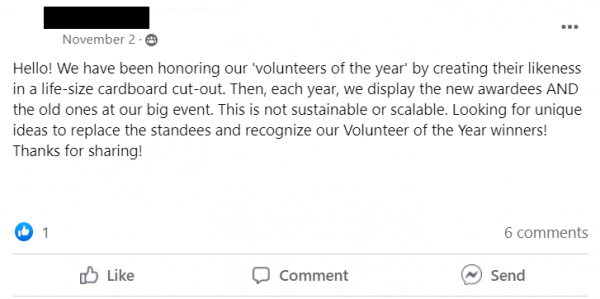
Comments from the group
“We send a crystal flame award to the recipient with a gift (currently a Yeti with our logo on it). The volunteer gets featured in our newsletter and on social media accounts. We then have a running list of recipients and their stories on our website. We are a national org.”
“Maybe a banner with an insert to place the photo, says Volunteer of the Year with dates and your company logo. Everyone in your company can sign it and then after your recognitions ceremony the banner can be gifted to the Volunteer of the Year.”

Comments from the group
- “Last year I got personalized wooden Christmas ornaments from Etsy. Less than $3 each and light to mail with a card.”
- “Our volunteers actually preferred experiences. We did a Paint Along With Bob Ross (you can find the videos on YouTube) that could be inexpensive if you can find cheap supplies. A special tour the public doesn't usually see. A volunteer cookie exchange party…”
- "Luggage tags, flashlights, water bottles. This year it's small wallets that can be hooked to a purse or backpack. Journals are good for teens."
- “We give a holiday card with a calendar/planner. Easy to mail, and while it seems old fashioned everyone looks forward to the new planners…even the teens. (250+ vols, healthcare).”
- “We’re looking at doing hand made magnets this year.. staff building event of making them together. Planning on a card with it say think you for helping us keep it together. We’re doing 3 with painting pours on it and one logo.”
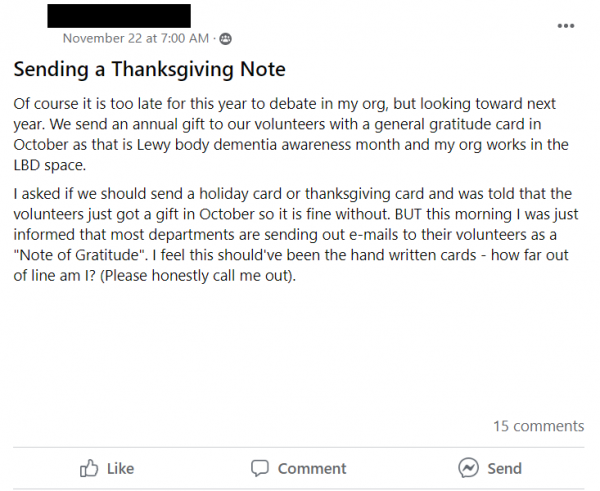
Comments from the group
- “I’m all about the handwritten note… takes a lot of time and effort but people seem to appreciate it. But in place of nothing, an email will do.”
- “There may be ways to spread out the work and/or use different methods. Depending on the number of volunteers, you can have staff write thank you notes throughout the year or send an email with a picture of the volunteer in action. We have a volunteer send a thank you note when someone volunteers for 10 hours. It’s a peer to peer way of welcoming new volunteers. I’d love to hear other ways people say thank you.”
- "Create a gratitude board where staff can write personal thank yous. I also took pictures and videos and sent them out with staff being grateful"
- “I create a graphic on Canva and email all of my volunteers with a sincere note of thanks (I have 200 vols and it’s just me so it would be impossible to send handwritten to everyone). They seem very appreciative of my emails at the holidays.”
Volunteer Recruitment and Retention
Recruiting During the Holidays and Beyond
Recruitment is important for any volunteer-run organization but demand for volunteers often increases around the holidays. Regular volunteers may not have the same availability, and your organization may be running additional holiday programs and drives. There are a variety of ways to assist with recruitment, whether it’s online, in person, or in print. There are also certain places that are better to recruit from, such as colleges, churches, and corporate offices. When it comes to retaining volunteers, you’ll want to make sure that their first experience is a good one, while also setting expectations about how holiday volunteering is different from your standard offerings if there is a difference. It’s also important to get contact information so you can keep in touch with these volunteers and promote future opportunities! See what our coordinator community suggests:
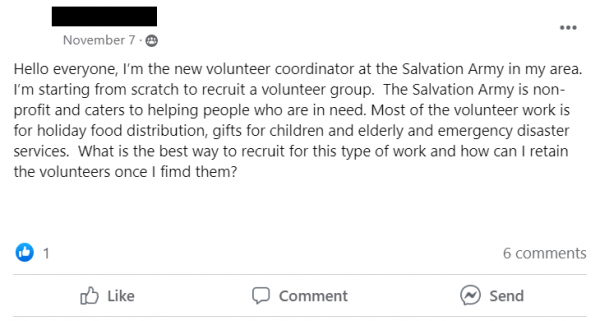
Comments from the group
“I also had to start from scratch when I started at my program. It’s all virtual thigh but still has to recruit from various sources. It’s exciting but a lot of work to begin a program. Of course sites like VolunteerMatch, Idealist, AARP, schools… Retention: I acknowledge start dates, anniversaries and birthdays. Send feedback from their volunteer work from the clients.”
“Facebook, flyers in churches, email teachers especially business classes or counselors. Have prepared dates, tasks and waiver forms-include photo releases.”
“I definitely would do VolunteerMatch, also if there are any colleges nearby. I would reach out to them and see if they can post the opportunity in their community fair engagement newsletters, etc.”
“My first job as a volunteer coordinator was with The Salvation Army. During the holidays, I actually had to turn people away because so many people would want to volunteer. Our biggest sources of volunteers were local colleges, military bases, churches, and corporate groups. Many corporate offices would volunteer as a team during the holidays for gift distribution.”
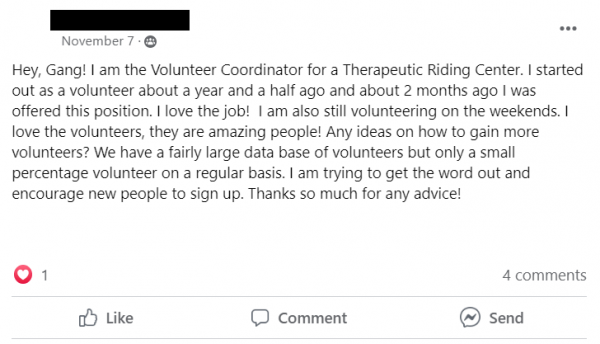
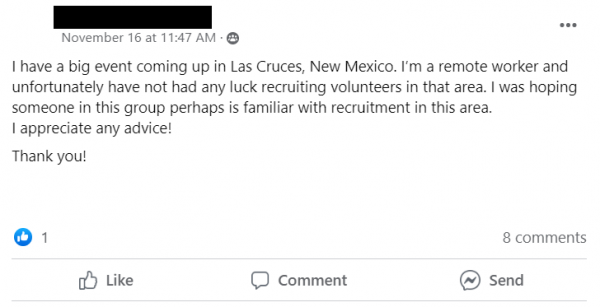
Comments from the group
- “Maybe sign up at local events to host a recruitment table or ask to leave flyers at recreational centers and public libraries. I use Canva to create flyers and include QR codes. Your organization sounds like a service military veterans would be interested in so maybe you can reach out to local Vet Centers, VA clinics, or VFW chapters and see if anyone would be interested to volunteer. You can also share flyers on the NextDoor App where your neighbors could spread the word too.”
- “Before going out and recruiting more, if you already have a good size database, find out why the other volunteers are not engaged. Sometimes this will give you a good an idea of any weak areas in your program. Sometimes it’s a matter of finding ways to engage the volunteers you already have as much as it can be recruiting new ones.”
- “Are there any corporations located [in the area you want to recruit]? How about churches & civic groups?”
- “Reach out to United Way. they may have a group of volunteers.”
- “Latter Day Saints have always been helpful…Check on www.justserve.org”
See all the comments here and here!
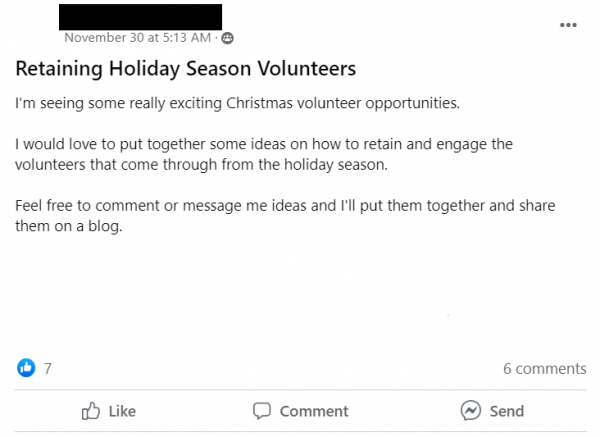
Comments from the group
- “If they have a good experience they will be back.”
- “I send out a weekly email (I call it a Volunteer Newsletter). It has significantly impacted volunteer retainment and activity. After implementing it, I have had 200+ more volunteer activities filled each month. It takes a little time each week- 1-2 hours. But the reward for doing it is significant…I use Canva and Constant Contact to send out the email so I can make it pretty and see who reads it and utilizes the links in the email…The email has links to our volunteer software, needs of the week, pictures that volunteers take, updates to the program, and updates to what was sent out in the previous email. I try to add a fun comic and pictures of animals smiling to impact volunteers' moods and make them feel happy.”
Volunteer Management
Volunteer Onboarding, Motivation, Coordinator Roles & More
Volunteer management is a core piece of any volunteer coordinator’s role. It often involves setting up processes to onboard and train volunteers, track hours, and keep volunteers motivated. If your organization is thinking of requiring background checks, you may want to see if they’re necessary for all volunteers or only a portion, since the process takes time and money. Another aspect of volunteer management is keeping volunteers motivated, especially when it comes to less popular tasks such as cleaning. Some ways to keep volunteers involved are making sure that expectations are set from the beginning, and having rotations so that each volunteer gets to participate in a variety of activities. You can also survey volunteers to get feedback on what keeps them coming back! It’s also important as a coordinator to examine your own motivations and be on the same page with your supervisor as to what the ideal coordinator role looks like for you both. And finally, one of the best ways to organize volunteers and your tasks as a coordinator is to invest in volunteer time tracking software. Software like Track it Forward can assist with onboarding, storing volunteer profile info, signing up for events and shifts, tracking progress toward milestones, and more! Take a look at our article on How to Choose the Right Volunteer Software for Your Organization, and check out advice from our coordinator community below!
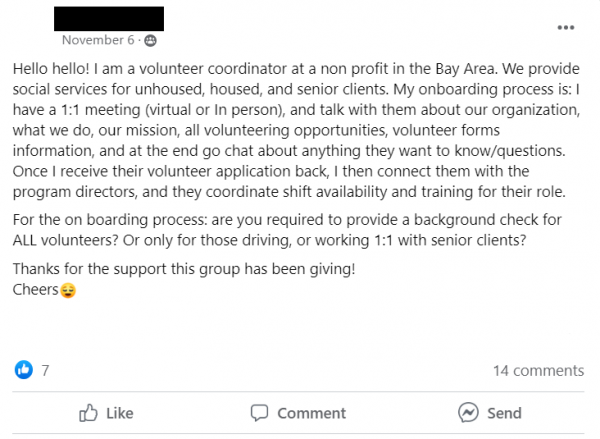
Comments from the group
- “We require a background check of all adult volunteers. (Industry: public library).”
- “Background checks on patient facing volunteers or those who have access to patient info.”
- “The groups that I have volunteered with that have asked for background checks it was because I was involved with sensitive groups - i.e. children or seniors. I understood when it was asked of me. There were times that I was asked to pay and others that the organization paid the cost. I am always looking for new ways to be of service but the times that I was asked to pay for the background check delayed my replies opposed to when the organization was paying for the background check.”
- “It is imperative you do a because with anyone working with people or sensitive information, which pretty much is everyone in my case. I work at a non-profit. We realize this may scare away potential volunteers but then this weeds out the non dedicated folks.”
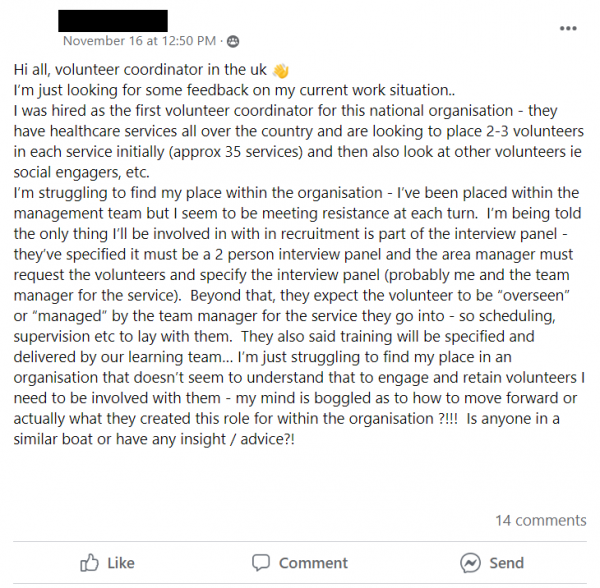
Comments from the group
- “My hospital uses a decentralized management model— similar to HR. So, as a Volunteer Coordinator, I am in charge of everything related to recruitment, scheduling, onboarding, general orientation, annual requirements, retention efforts, etc. But the volunteers are supervised in their individual assignments by “subject matter experts”, which is basically just a staff person who works full-time in those spaces and knows the patients, families, and other staff there the best.”
- “If I understand correctly, this looks like a good system. When I had people asking me to manage their volunteers, I always responded, would you ask HR to line-manage your staff. With this model, you will have enough time to engage with your volunteers. I had volunteers across London, South East and had lead volunteers manage and then I managed the lead volunteers.”
- “I am in a similar position with a national organization in the US. Additional challenges for myself are varying views on how the volunteers should be onboarded. I am finding that because everyone has done what they wanted (overall not just with volunteers) it is a challenge to have people get on the same page with what my role is. Not only do I have to start getting volunteers to buy in, but I also have to get staff to buy in…I have also found opportunities so now not only am I doing on boarding but I am also doing a variety of recognition projects. Through recognition and onboarding I get to talk to a variety of the volunteers and they get to know me. I tell them I am available and I share my work cell and e-mail. Then they share it with other volunteers. I reassure the volunteers that I am not replacing their managing staff but am an additional resource, and everyone seems on board with that.”
Read more and share your thoughts here!
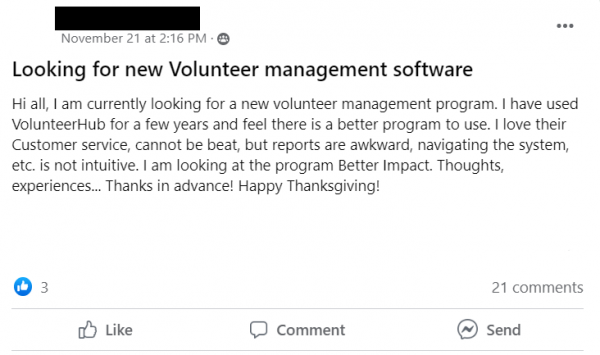
Comments from the group
- “We are using Track it Forward. And it’s great! We’ve bounced between Volunteer Reporter, GiveGab, Give Pulse and Oncorps. Track it forward is my favorite so far!”
- “We have our own system. Just been put on the NHS framework. We currently have 170 volunteers…[we] allocate sessions which volunteers accept and then you know who’s at each location. Also has a learn section that has all our volunteer training needs. Plus other features like HR and compliance etc.”
- Article: How to Choose the Right Volunteer Software for Your Organization
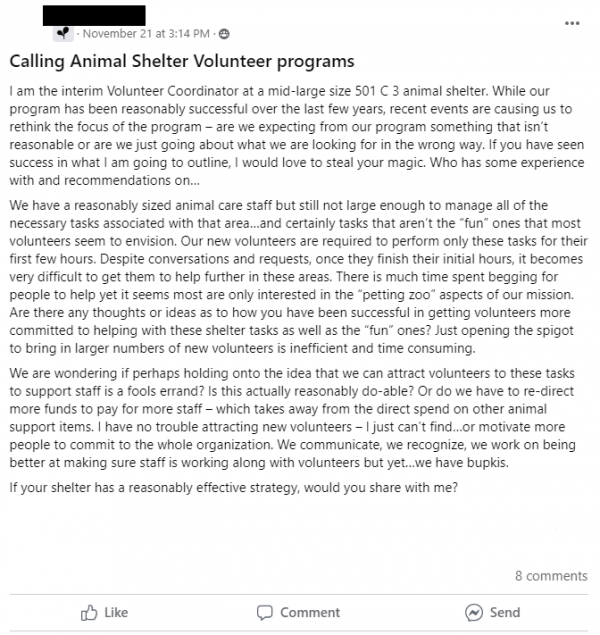
Comments from the group
- “…I've made those "operational" tasks a core component of general training to get across that we can all play a role on getting these vital tasks done, stress that these tasks still help the animals and if we spent 10-25 minutes doing laundry during our shift that's time the staff can devote to animals...we've had it happen organically that several volunteers have just gravitated towards those "back of house" roles.”
- “I'm not in animal care but we have our "booooo!" tasks set up for the front of shift, so that you have to do them to get to the "good stuff".”
- “I also put it out there in my orientation that if that is all they want to do, this is not the place for them because all animals should have the 5 freedoms met before anything else.”
- “My advice is to let go a little and try not to expect more than your volunteers have shown you they’re willing to give. I’ve had this struggle too and like others have said, a few volunteers will really gravitate towards the cleaning and chores because they see that it desperately needs to be done. But if the work the other volunteers are doing is still important work that needs to be done, there’s no point in trying to force them to do tasks they don’t want to do. It will drive them away and then there won’t be anyone filling either role.”

Comments from the group
- “Historically I've occasionally surveyed our volunteers, or just casually talked to them when they're serving and asked why they choose to spend their free time with us. This has helped to inform how to shape their experiences to be mutually beneficial.”
- “Also check out Dan Pink's Ted talk on motivation.”
- “We've been asking this question on our annual volunteer survey for the last few years...I think the motivation will depend on the mission of your organization. One surprise to me was how high socio-connection is a motivator. A summary is: What is your motivation for volunteering with the City of Columbia? 1. Public Service – My volunteering helps the community 2. (tied) Personal Satisfaction, Opportunities to be outdoors and enjoy nature 4. Make an impact on sustainability (recycling, waste and energy reduction) 5. Meet new people. Since we are local government and do a lot in parks and litter/recycling, these results make sense to us but may not if your organization has a different mission.”
 Written by
Written by